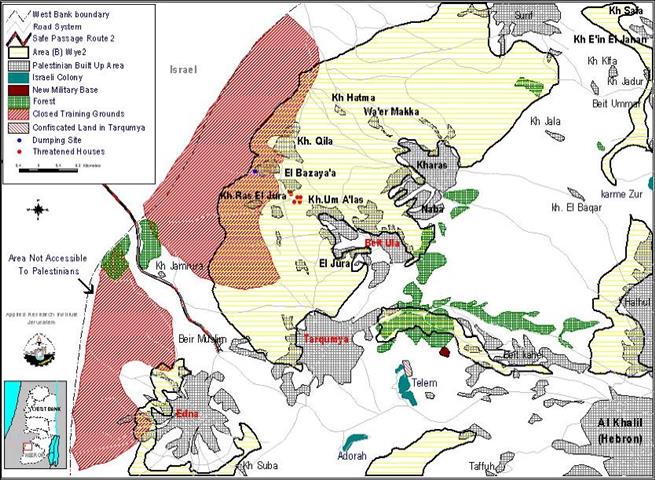On the 15th of May 1999, 16 Israeli military orders were approved by the Israeli military command sealing off large areas of land in the West Bank as closed training grounds. Two of these orders concern areas belonging to the Palestinian villages of Beit Ula (population 6,815) and Edna (population 13,541) 10km northwest of Hebron (Figure 1).
Figure 1 Map showing Beit Ula, Edna, and the newly closed areas.
However, the villagers were not informed of these orders until the 6th of September 1999 (i.e. after the signing of the Sharm El Sheikh Memorandum which was on the th of September,1999). In Beit Ula 13,000 dunums were included in the closure, while in Edna 10,000 dunums.
Yet, according to the Sharm El Sheikh Memorandum (alternatively known as Wye 2), around 5,000 dunums out of Beit Ula's 13,000 expropriated dunums and 950 dunums of Edna's 10000 expropriated dunums lie in Area B (Figure 2). In fact, a number of Palestinian houses are threatened with demolition despite the fact that they lie in Area B. The area also includes a dumping site and a factory employing 20 Palestinian workers (Figure 3).
Figure 2 Part of the closed area.
Figure 3 The dumping site.
Moreover, the military orders specifically state that the closure does not apply to persons living within the designated area. Nevertheless, in Beit Ula several people of the Ajarmeh family living within the closure area were ordered to leave. Prior to these orders, thirteen families were notified that their houses would be demolished under the pretext that they were built without permits (Figure 4).
Figure 4 The houses threatened with demolition
Since most of the land is agricultural, these live-fire training grounds affect around 200 families that make their living from agriculture and livestock. Moreover, the proximity of the closures to Palestinian built up areas impedes their development and natural growth.
Usually, the closing of an area for military training is limited by a specific time period; those of Beit Ula and Edna are open-ended. Thus, claiming that these orders are administrative and routine (i.e. independent of political developments) is invalid. Indeed, upon closer inspection of the location of the closures the real reasons behind them could be foretold:
Firstly, the two closure areas flank the provisional 'Safe Passage' route from both sides. This works quite well with the IDF's endeavor to control the 'Safe Passage' route even in areas that are expected to be under Palestinian authority.
Secondly, both areas lie near the Green-line (the 1949 armistice line separating the West Bank from Israel). Locating the training grounds specifically there denotes an Israeli intention to exclude the West Bank's border areas from any settlement over the boundaries of the proposed Palestinian State.
Thirdly, the location of the closure near Edna produces an additional area that is inaccessible to Palestinians by virtue of its lying between the 'Green-line' and the closed area. Thus, Israel closes off an area practically without doing so officially (see map).
Recently, another 40 dunums, belonging to the Saqur and Al-Muraqtan families of Tarqumiya village that lies between Edna and Beit Ula was expropriated for the expansion of Telem settlement (Figure 5 ). The villagers mentioned that the land used to be cultivated with olive trees until five years ago when settlers uprooted them. Not only that, but also a new military outpost overlooking areas transferred to Area B according to Sharm El Sheikh Memorandum has been reported in the vicinity (Figure 6 ).
Figure 5 The expropriated land with Tarqumiya in the background.
Figure 6 The new military outpost.
Unilateral Israeli practices such as those defy the Fourth Geneva Convention and basic principles of international law. Nevertheless, the Israeli government continues to transgress the rights of Palestinians unabated.
Prepared by:
The Applied Research Institute – Jerusalem



















